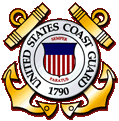



![]()




The Coast Guard Destroyer Tucker, flagship of the New London Destroyer Force. Originally commissioned by the Navy in 1916, she was transferred to the Coast Guard in 1926 and served until 1933.]
Manning this fleet was a force of some 4,000. More accurately, this number was spread among cruising vessels, harbor tugs, surfboats, beach patrols, and other land stations. Pay was comparable to other military men of the era and certainly not generous. The lowest-ranking officers brought home something less than $130 per month. The Commandant was paid $6000 per year. A new recruit had a four- year commitment and drew $21 per month.
If these statistics are not sufficient to prove the Coast Guard’s numerical inferiority as Prohibition began, it should be kept in mind that then, as now, the business of enforcing revenue laws is far from the sole mission of the service. Alexander Hamilton, the first Secretary of the Treasury, had founded his little navy as a "show of force" to overawe the "fraudulent few" involved in illicit trade, but the years had seen the service encrusted with multiple tasks, few of which enhanced, or even related to, the original intent. These were: protecting life and property at sea, maintaining military readiness, the Bering Sea Patrol, the Atlantic Ice Patrol, various services to shipping, and removal of derelicts from sea lanes.
In the 1921 fiscal year, for example, 14,000 persons were assisted, of which over 1,600 were in peril. Routine ship inspections numbered some 18,000. Assistance to those in danger was the most vital role of the service despite its origins as a revenue enforcement agency, Prohibition would do nothing to enhance or facilitate this mission.

"U.S. Coast Guard officer examining a suspected smuggler." Photo No. 1-7-27 N; 1927; photo by United News Pictures.

From the Ft. Lauderdale Sun
Sentinel. At 06:04am Aug. 17, 1928, Horace Alderman was
"hung" at the U.S. Coast Guard Station at what is now Bahia Mar Marina
Broward County, Florida. Alderman, a rum-runner during Prohibition days in the
1920s, was smuggling a boatload of booze into Florida from the Bahamas when he
was intercepted by a Coast Guard Cutter. In the ensuing shoot-out he killed
three men. A federal judge sentenced the Gulf Stream
Pirate to death by hanging in the county seat of the county he re-entered on his
return to the United States. Broward County had no idea about how to hang a
murderer, so the unhappy task was palmed off on the Coast Guard. Note, and
information from Jay McCarthy LSA Member. I never knew the Coast Guard to hang
anyone (Perhaps they did in Pirate days).
 To Lightship Stations and the Ships that
Served on them.
To Lightship Stations and the Ships that
Served on them.
Copyright © 2004 United States Coast Guard Lightship Sailors Association
INC. All rights reserved.
Copyrights also protected by the Digital Millennium Copyright Act of
1998
Revised: 10/23/06.